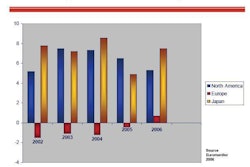After two months of the seemingly endless turmoil, chaos and heartbreak of the petfood recall situation - arguably the most significant thing to hit our industry in many years - one theme cries out loud and clear. The global food supply chain, for both pets and humans, needs serious reform.
By now everyone knows some of the petfood contaminated with melamine and/or cyanuric acid ended up going into animal feed via the common practice of selling leftover materials from petfood plants to feed producers. That feed was eaten by chickens and hogs that entered the US human food supply.
While any melamine or cyanuric acid consumed by humans would have been extremely diluted, this chain of events, and the realization that the animal and human food chains are so inextricably linked, seemed to take some people by surprise. What may be even more startling is that the US Food and Drug Administration (FDA), the main agency charged with safeguarding the US food supply, isn't sure if any tainted ingredients entered the human food chain by a more direct route.
Not limited to petfood
Media reports have lambasted the petfood industry over a perceived lack of quality control and supplier oversight in the wake of the recalls, but it's becoming clear that existing problems and potential dangers in the US are not limited to petfood. For proof, you need look no further than the Salmonella contamination of peanut butter earlier this year or the E. coli in spinach last year.
On p. 28 of this issue, a story about the contaminated petfood ingredients from the China perspective points out how uncoordinated and disjointed Chinese food regulations are. Joanna Brent, team leader for the World Health Organization in China, says nine governmental institutions have some authority over food safety, with another eight taking secondary roles.
Considering that China is still developing as a modern economy and society, its situation may not be all that shocking. But this is: In the US, 12 different federal agencies have oversight of the food supply, operating under 35 health-related statutes and more than 50 interagency agreements and reporting to 28 US Congressional committees. This is according to a 1998 study by the Institute of Medicine and National Research Council called Ensuring Safe Food: From Production to Consumption (available at http://books.google.com), which was referenced in a May editorial in the Lancet (www.thelancet.com).
No quick fix
Though the US Congress has introduced legislation to consolidate food safety oversight under the FDA, there's no guarantee that will lead to better funding and staffing so the agency can carry out even its existing tasks, let alone new ones. (Currently the FDA oversees 80% of the US food supply but receives only 20% of the funding, according to CNN.com.) And reform won't come quickly; new regulations and laws can take months or years for passage and implementation.
Perhaps a faster and at least partial solution is for industry to step up. ChemNutra, the supplier that imported the contaminated wheat flour, is calling for a summit on petfood ingredients to draft voluntary import standards (see "Industry News," p. 13). Some petfood manufacturers are increasing their oversight of ingredient sourcing and suppliers, as well as contract manufacturing. (Though some companies' pledges that they will no longer outsource their manufacturing or use materials imported from China seem rather unrealistic.)
There's no doubt that in the wake of the recalls, the industry must change. And those changes will affect business models and the economics of the supply chain. Let's hope pet owners, who have proven to spend increasingly on their beloved furry charges, are willing to pay even more to ensure the safety of their pets' food.
















